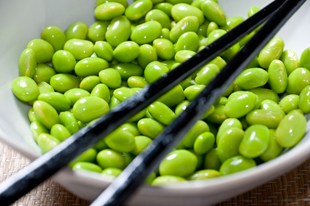Selecting Healthy Proteins for the Aging Body
All protein is digested into amino acids, whether the protein comes from an animal or a plant, so when considering our protein, we are really considering its complement of amino acids, as well other nutrients and toxins that are ingested at the same time. These should be our main concern when looking for protein. “Does it come with fat or calories?” – So we choose the leanest meat. “Can I get it with added vitamin and fibre?” – So substitute plant proteins, or perhaps fish, for your omega-3 dose.
Plant Proteins
Eat a broad range of plant foods ad libitum to support protein and aging
- A mixed vegetable meal, including quinoa can provide all the protein of a steak, with far less fat, and provide the bonus of fiber, vitamins and minerals.
- Complete protein for aging requirements are found in soy products, quinoa, spirulina, buckwheat and amaranth. Try substituting rice with quinoa as it is a high protein grain with a nutty flavor similar to rice.
- Tofu and soy are good vegetarian protein sources for the aging body with the added benefits of isoflavones. Use tofu in stir fries, curries and casseroles as an animal protein substitute.
- While canned foods are not the first choice with most foods, canned legumes retain their nutritional value and are quicker and more convenient than preparing beans at home. Choose from lentils, kidney beans, chick peas, broad beans, baked beans (drain off the sauce), mixed bean varieties and use them in salads, Mexican style dishes, soups and stews.
Red Meat
Eat it no more than twice a week
(one serve = 100g or a piece the size of the palm of your hand)
- Chose lean cuts and lean meats (such as kangaroo).
- We can get the added bonus of essential fatty acids when aging by choosing meat from grass fed rather than grain fed herds.
- Don’t overcook your beef for flavor. Find another way.
- Avoid cured, smoked and processed meats.
Chicken
Eat it no more than twice a week
(one serve = 100g, one drumstick or half a small chicken breast)
- Discard the skin and chose lean cuts.
- We are after protein not pesticides or antibiotics, so choose organic.
- We can get the added bonus of essential fatty acids by choosing free range chickens rather than factory fed ones (modern farming methods have led to the development of chicken feed that produces an imbalance of omega-6:omega-3 (the ratio needs to be less than 4:1).
- Don’t overcook your chicken.
Eggs
Eat no more than 7 eggs a week to get your protein
- We can get the added bonus of essential fatty acids by choosing free range eggs rather than factory fed hens.
- Keep a few chickens in your own backyard. They are great consumers of kitchen scraps!
Milk
No more than 1 cup per day
(so minimise your milk consumption)
- Grass fed cows have much higher levels of essential fatty acids.
- We are after calcium, but calcium can be found elsewhere.
- Saturated fat is our enemy. Low fat milk has less fat but also less fat-soluble vitamins (e.g. vitamin A, D, E and K) and less available calcium. Fortified products can make up for these changes (e.g. choose fortified low fat milk).
- Choose probiotic dairy products such as yoghurt to get calcium and the added bonus of intestinal health. But watch out, low fat generally means high sugar and high GI, so it’s best mixed with fiber (e.g. bran for breakfast).
| Instead of… | Try…. |
| Milk | Rice milk, soy milk, almond milk, goat’s milk |
| Cow’s milk yoghurt | Keffir, sheep’s milk yoghurt, soy milk yoghurt |
| Ice cream | Frozen fruit smoothie or sorbet |
| Cream | Coconut cream |
| Cow’s milk cheese | Sheep or goat’s milk cheese.In general hard cheeses are a better alternative if we can tolerate cow’s milk e.g. parmesan.Avoid soft cheeses |
Fish
Up to 7 serves per week
(1 serve = 100-150g of fish or the size of your palm)
- All fish are an excellent source of lean protein as you age.
- Cold water oily fish (such as salmon, herring, mackerel, anchovies, sardines and to a lesser extent tuna) have the added bonus of essential fatty acids.
- If the fish is farmed then it is generally higher in omega-6 and lower in omega-3.
- Long-living predatory fish, like swordfish and shark, may accumulate toxins such as heavy metals PCBs, furans and dioxins.
- Canned tuna has less chemical residues than fresh tuna because the smaller fish are used in the canning process.
- As omega-3’s are generally unstable in heat, any health benefits may be lost along with the omega-3, by frying or overcooking fish.
Last Reviewed: 27-Jan-2014






